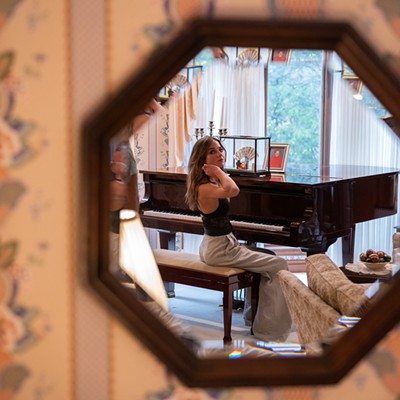THE GOOD THIEF
DOUBLE CROSSES
Jean-Pierre Melville's Bob le Flambeur opens with a glistening panorama of Paris at night photographed from Montmartre, the alabaster 19th-century church on a hilltop that overlooks the Pigalle, Paris' red-light district, where one of the red lights these days is the neon burst of the Moulin Rouge. From there, we come down to street level and soon meet Bob, a high roller (flambeur) who makes his living as a gambler, having learned, 20 years and a jail sentence ago, that he's not much of a thief.
That was in 1955, when film noir was á la mode, especially among French filmmakers enamored with the American style, and when the French New Wave was poised to be cut from the moody visual cloth of modish directors like Melville (née Jean-Pierre Grumbach).
Half a century later, the Irish-Hollywood director Neil Jordan has updated Melville's story of an aging gambler and made it The Good Thief, which has a more complicated plot and, despite its shadows and whispers, a less complicated psychology. This version of Bob's story, at once more pained and more sanguine, is moodily reminiscent of numerous other neo-cinema styles, replete with the director's Catholic interest in sin and redemption, and with an ending borrowed (and modified) from his own demi-masterpiece, Mona Lisa.
"The good thief" of Christian lore is the man who died on the cross next to Jesus, and whom, the story goes, Jesus took with him to Paradise. Jordan's Bob (Nick Nolte) is dying, but he's doing it by self-destruction, not by Roman edict. The son of an American G.I. and a French woman, he's all-American but living now in Paris because he apparently can't go home. He's been convicted of crimes six times, so now he just gambles, dealing himself out of a hand to shoot up with heroin in the back room of a filthy gambling den located inside a sex-and-strip club. (Melville's Bob played in much more low-keyed and hygienic settings.)
He's haggard, of course -- this is Nick Nolte -- but his mind is sharp when it's not stoned. His wit is wry, his nature paternal: Handsome young Paulo (Saïd Taghmaoui) is Bob's eager protégé, and soon Bob becomes an ineffective sage to Anne (Nutsa Kukhianidze), a worldly waif of 17 who drifts from man to man in her lacy black unmentionables, and whom Bob tries to settle down and get off drugs by introducing her to Paulo.
Then, just when Bob is perfectly happy gambling and killing himself, along comes the only temptation left: pulling off a colossally slick heist at a classy Monte Carlo casino. ("Either someone just walked over my grave," Bob says when he hears the plan, "or I'm going through withdrawal.") It's an impossible job -- so impossible, in fact, that it's only a diversion. The gang will find a proper Judas, make sure he tells the cops, and in the meantime, they'll really be stealing the casino's art masterpieces from an ultra-secure nearby building that's protected by an impenetrable security system -- designed by one of their co-conspirators (Emir Kusturica).
From there, The Good Thief is pretty much a caper film, although Jordan cares so little for the intricacies of the heist plot that he barely allows us to understand it (not, of course, that it can be understood). That leaves him with a winnowing character study that he overstuffs with music and style. The Good Thief needs to be quiet, steady and intimate if we're to take much away from it. Bono covers "That's Life" nicely, and Leonard Cohen sings a gloomy ballad that follows the fated players. But the rest of the incessant soundtrack is either languid club jazz or Euro-pop dance music. It clutters things up, and despite some beautifully filthy production design, so does Jordan's twitchy camera and murky lighting. Melville filmed a delectable travelogue of a dynamic city that gets dark only at night; Jordan needs to let Paris be Paris.
The Good Thief has a weirdly international cast: Roger, Bob's friendly old police detective foe, is the French actor Tchéky Karyo, and the American twins Mark and Michael Polish play a pair of cagey Irishmen. Taghmaoui is French-Moroccan. Kusturica is Bosnian but plays a Russian. So does Kukhianidze, whose name is Georgian. There's also a French-Algerian and a German in the mix. This all adds little more than a series of accents to negotiate (not too difficult), and when the French cops speak to one another, you're reminded that Jordan probably chose not to film his movie in French because English was more commercial.
Jordan's dialogue in The Good Thief often crackles with sharp rhetoric like a street-life drama should, although what can we make of an out-of-the-blue assertion, spoken by a sleazy British art dealer (Ralph Fiennes in a clever cameo), who quips, "Isn't that a contradiction: a good fake, a happy homosexual?" (Is Jordan recalling his own overrated The Crying Game?) The movie's pace, often surprisingly brisk, wavers between sexy savior faire and heavy-handed sophistication. The actors are largely unimportant, even Nolte, whose craggy sparkle we've come to expect and love. And if you like real-life subtexts, then you'll love the passage in The Good Thief where Bob -- who's understandably deft at 12-step humor -- handcuffs himself to his bed for three days so he can withdraw from his addiction and then be clear-headed for the work that lies ahead. * * 1/2
That was in 1955, when film noir was á la mode, especially among French filmmakers enamored with the American style, and when the French New Wave was poised to be cut from the moody visual cloth of modish directors like Melville (née Jean-Pierre Grumbach).
Half a century later, the Irish-Hollywood director Neil Jordan has updated Melville's story of an aging gambler and made it The Good Thief, which has a more complicated plot and, despite its shadows and whispers, a less complicated psychology. This version of Bob's story, at once more pained and more sanguine, is moodily reminiscent of numerous other neo-cinema styles, replete with the director's Catholic interest in sin and redemption, and with an ending borrowed (and modified) from his own demi-masterpiece, Mona Lisa.
"The good thief" of Christian lore is the man who died on the cross next to Jesus, and whom, the story goes, Jesus took with him to Paradise. Jordan's Bob (Nick Nolte) is dying, but he's doing it by self-destruction, not by Roman edict. The son of an American G.I. and a French woman, he's all-American but living now in Paris because he apparently can't go home. He's been convicted of crimes six times, so now he just gambles, dealing himself out of a hand to shoot up with heroin in the back room of a filthy gambling den located inside a sex-and-strip club. (Melville's Bob played in much more low-keyed and hygienic settings.)
He's haggard, of course -- this is Nick Nolte -- but his mind is sharp when it's not stoned. His wit is wry, his nature paternal: Handsome young Paulo (Saïd Taghmaoui) is Bob's eager protégé, and soon Bob becomes an ineffective sage to Anne (Nutsa Kukhianidze), a worldly waif of 17 who drifts from man to man in her lacy black unmentionables, and whom Bob tries to settle down and get off drugs by introducing her to Paulo.
Then, just when Bob is perfectly happy gambling and killing himself, along comes the only temptation left: pulling off a colossally slick heist at a classy Monte Carlo casino. ("Either someone just walked over my grave," Bob says when he hears the plan, "or I'm going through withdrawal.") It's an impossible job -- so impossible, in fact, that it's only a diversion. The gang will find a proper Judas, make sure he tells the cops, and in the meantime, they'll really be stealing the casino's art masterpieces from an ultra-secure nearby building that's protected by an impenetrable security system -- designed by one of their co-conspirators (Emir Kusturica).
From there, The Good Thief is pretty much a caper film, although Jordan cares so little for the intricacies of the heist plot that he barely allows us to understand it (not, of course, that it can be understood). That leaves him with a winnowing character study that he overstuffs with music and style. The Good Thief needs to be quiet, steady and intimate if we're to take much away from it. Bono covers "That's Life" nicely, and Leonard Cohen sings a gloomy ballad that follows the fated players. But the rest of the incessant soundtrack is either languid club jazz or Euro-pop dance music. It clutters things up, and despite some beautifully filthy production design, so does Jordan's twitchy camera and murky lighting. Melville filmed a delectable travelogue of a dynamic city that gets dark only at night; Jordan needs to let Paris be Paris.
The Good Thief has a weirdly international cast: Roger, Bob's friendly old police detective foe, is the French actor Tchéky Karyo, and the American twins Mark and Michael Polish play a pair of cagey Irishmen. Taghmaoui is French-Moroccan. Kusturica is Bosnian but plays a Russian. So does Kukhianidze, whose name is Georgian. There's also a French-Algerian and a German in the mix. This all adds little more than a series of accents to negotiate (not too difficult), and when the French cops speak to one another, you're reminded that Jordan probably chose not to film his movie in French because English was more commercial.
Jordan's dialogue in The Good Thief often crackles with sharp rhetoric like a street-life drama should, although what can we make of an out-of-the-blue assertion, spoken by a sleazy British art dealer (Ralph Fiennes in a clever cameo), who quips, "Isn't that a contradiction: a good fake, a happy homosexual?" (Is Jordan recalling his own overrated The Crying Game?) The movie's pace, often surprisingly brisk, wavers between sexy savior faire and heavy-handed sophistication. The actors are largely unimportant, even Nolte, whose craggy sparkle we've come to expect and love. And if you like real-life subtexts, then you'll love the passage in The Good Thief where Bob -- who's understandably deft at 12-step humor -- handcuffs himself to his bed for three days so he can withdraw from his addiction and then be clear-headed for the work that lies ahead. * * 1/2














